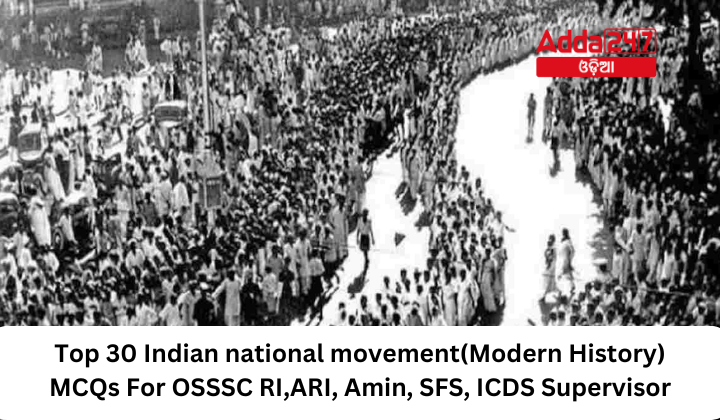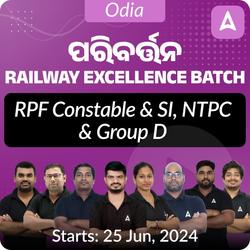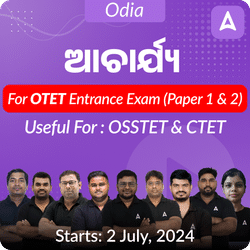The Indian National Movement is a pivotal chapter in modern Indian history, marked by relentless struggles against colonial rule and efforts towards independence. For aspirants preparing for OSSSC RI, ARI, Amin, SFS, ICDS Supervisor exams, understanding this period is crucial. Here’s a curated set of 30 Multiple Choice Questions (MCQs) that will help you assess and deepen your knowledge of this significant era:
Top 30 Indian national movement(Modern History) MCQs For OSSSC RI,ARI, Amin, SFS, ICDS Supervisor
- Who were the prominent leaders during the Moderate Phase of the Indian National Movement?
A. Mahatma Gandhi
B. Dadabhai Naoroji
C. Bal Gangadhar Tilak
D. Subhas Chandra Bose
Answer: B. Dadabhai Naoroji
Explanation: Dadabhai Naoroji, Gopal Krishna Gokhale, and others were prominent leaders during the Moderate Phase (1885-1905). - What was the primary objective of the Extremist Phase of the Indian National Movement?
A. Complete Independence (Swaraj)
B. Dominion Status within the British Empire
C. Social Reforms
D. None of the above
Answer: A. Complete Independence (Swaraj)
Explanation: The Extremist Phase (1905-1919) aimed at achieving complete independence from British rule, shifting away from the earlier goal of Dominion Status. - Which event acted as a catalyst for the rise of Extremism in the Indian National Movement?
A. Champaran Satyagraha
B. Non-Cooperation Movement
C. Partition of Bengal
D. Jallianwala Bagh Massacre
Answer: C. Partition of Bengal
Explanation: The Partition of Bengal in 1905 sparked widespread protests and catalyzed the rise of Extremism in the movement. - Who among the following leaders advocated non-violent resistance during the Gandhian Phase?
A. Bal Gangadhar Tilak
B. Lala Lajpat Rai
C. Mahatma Gandhi
D. Bipin Chandra Pal
Answer: C. Mahatma Gandhi
Explanation: Mahatma Gandhi introduced the philosophy of non-violence (Satyagraha) during the Gandhian Phase (1919-1947). - Which movement marked a significant turning point during the Gandhian Phase due to its call for “Do or Die”?
A. Non-Cooperation Movement
B. Civil Disobedience Movement
C. Quit India Movement
D. Individual Satyagraha
Answer: C. Quit India Movement
Explanation: The Quit India Movement (1942) marked a significant turning point in the Gandhian Phase with its call for “Do or Die.” - The Surat Split in 1907 occurred due to:
A. Differences between Moderates and Extremists
B. Partition of Bengal
C. British repression
D. Introduction of separate electorates
Answer: A. Differences between Moderates and Extremists
Explanation: The Surat Split was caused by disagreements between Moderates and Extremists within the Indian National Congress. - Which legislative act introduced limited Indian representation in 1909?
A. Government of India Act, 1935
B. Indian Councils Act of 1909 (Minto-Morley Reforms)
C. Rowlatt Act
D. Simon Commission
Answer: B. Indian Councils Act of 1909 (Minto-Morley Reforms)
Explanation: The Minto-Morley Reforms introduced limited Indian representation in the legislative councils. - The movement associated with the boycott of foreign goods and promotion of Swadeshi was:
A. Non-Cooperation Movement
B. Civil Disobedience Movement
C. Khilafat Movement
D. Swadeshi Movement
Answer: D. Swadeshi Movement
Explanation: The Swadeshi Movement (1905) advocated the boycott of foreign goods and promotion of Indian-made products. - The incident that led to widespread protests against the Rowlatt Act in 1919 was:
A. Jallianwala Bagh Massacre
B. Champaran Satyagraha
C. Kheda Satyagraha
D. Bardoli Satyagraha
Answer: A. Jallianwala Bagh Massacre
Explanation: The Jallianwala Bagh Massacre (1919) triggered widespread protests against the Rowlatt Act. - Which phase of the Indian National Movement culminated in India gaining independence?
A. Moderate Phase
B. Extremist Phase
C. Gandhian Phase
D. None of the above
Answer: C. Gandhian Phase
Explanation: The Gandhian Phase (1919-1947) culminated in India gaining independence from British rule in 1947. - Who was the first President of the Indian National Congress (INC)?
A) Dadabhai Naoroji
B) Gopal Krishna Gokhale
C) Womesh Chunder Bonnerjee
D) Surendranath Banerjee
Answer: C) Womesh Chunder Bonnerjee - Which leader popularized the concept of “Drain of Wealth” from India to Britain?
A) Dadabhai Naoroji
B) Gopal Krishna Gokhale
C) Bal Gangadhar Tilak
D) Bipin Chandra Pal
Answer: A) Dadabhai Naoroji - What was the primary objective of the Indian National Congress during the Moderate Phase?
A) Complete Independence (Swaraj)
B) Economic Self-sufficiency
C) Dominion Status within the British Empire
D) Religious Reforms
Answer: C) Dominion Status within the British Empire - Who among the following leaders advocated for the use of constitutional methods and petitions to achieve political reforms?
A) Bal Gangadhar Tilak
B) Bipin Chandra Pal
C) Gopal Krishna Gokhale
D) Lala Lajpat Rai
Answer: C) Gopal Krishna Gokhale - The “Ilbert Bill” controversy was related to:
A) Educational reforms
B) Racial discrimination in judiciary
C) Land revenue policies
D) Indigo cultivation
Answer: B) Racial discrimination in judiciary - Who was the British sympathizer and supporter of the Indian National Congress?
A) Lord Curzon
B) Lord Mountbatten
C) William Wedderburn
D) Lord Macaulay
Answer: C) William Wedderburn - Which session of the Indian National Congress saw the introduction of the “Drain Theory” by Dadabhai Naoroji?
A) Bombay, 1885
B) Calcutta, 1906
C) Lahore, 1929
D) Madras, 1887
Answer: D) Madras, 1887 - Who among the following was known for advocating “Sarvajanikarana” or public participation in government?
A) Gopal Krishna Gokhale
B) Bal Gangadhar Tilak
C) Bipin Chandra Pal
D) Dadabhai Naoroji
Answer: A) Gopal Krishna Gokhale - The main focus of the Moderates’ efforts was on:
A) Cultural revival
B) Economic policies
C) Civil rights and political reforms
D) Armed resistance
Answer: C) Civil rights and political reforms - The Moderates believed in achieving political reforms through:
A) Non-cooperation and civil disobedience
B) Armed revolution
C) Petitions and negotiations
D) Religious reforms
Answer: C) Petitions and negotiations - Who founded the Poona Sarvajanik Sabha, an organization promoting social and economic reforms?
A) Mahadev Govind Ranade
B) Bal Gangadhar Tilak
C) Bipin Chandra Pal
D) Gopal Krishna Gokhale
Answer: A) Mahadev Govind Ranade - Which British policy during the Moderate Phase sparked widespread resentment among Indians due to its oppressive nature?
A) Arms Act
B) Vernacular Press Act
C) Pitt’s India Act
D) Rowlatt Act
Answer: B) Vernacular Press Act - Who among the following was the President of the Indian National Congress in 1901?
A) Surendranath Banerjee
B) Dadabhai Naoroji
C) Dinshaw Wacha
D) George Yule
Answer: C) Dinshaw Wacha - Which session of the Indian National Congress saw the emergence of a constructive dialogue between Indian leaders and the British government?
A) Calcutta, 1906
B) Madras, 1887
C) Bombay, 1885
D) Lahore, 1929
Answer: B) Madras, 1887 - The founding of the Indian National Congress (INC) in 1885 aimed primarily at:
A) Launching armed resistance
B) Gaining political rights for Indians
C) Promoting religious reforms
D) Implementing economic policies
Answer: B) Gaining political rights for Indians - Who famously declared, “Swaraj is my birthright and I shall have it”?
A) Dadabhai Naoroji
B) Bal Gangadhar Tilak
C) Bipin Chandra Pal
D) Lala Lajpat Rai
Answer: B) Bal Gangadhar Tilak - Which event marked the beginning of the Extremist Phase of the Indian National Movement?
A) Partition of Bengal
B) Morley-Minto Reforms
C) Lucknow Pact
D) Surat Split
Answer: A) Partition of Bengal - the Extremists advocated for:
A) Dominion Status
B) Religious reforms
C) Complete self-government (Swaraj)
D) Economic reforms
Answer: C) Complete self-government (Swaraj) - The Swadeshi Movement aimed at:
A) Promoting communal harmony
B) Boycotting foreign goods
C) Supporting British industries
D) Implementing agrarian reforms
Answer: B) Boycotting foreign goods - Who led the Champaran Satyagraha in 1917?
A) Jawaharlal Nehru
B) Subhas Chandra Bose
C) Mahatma Gandhi
D) Bhagat Singh
Answer: C) Mahatma Gandhi










